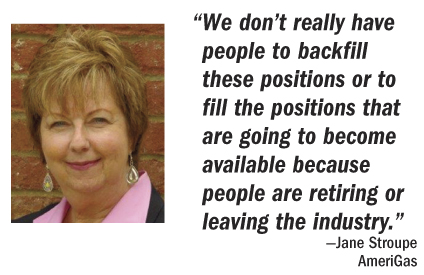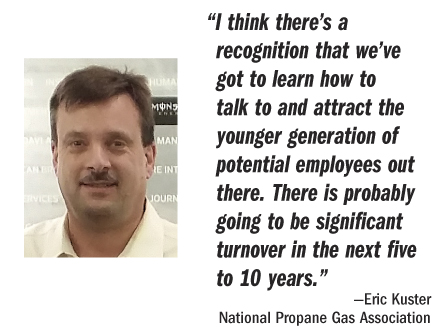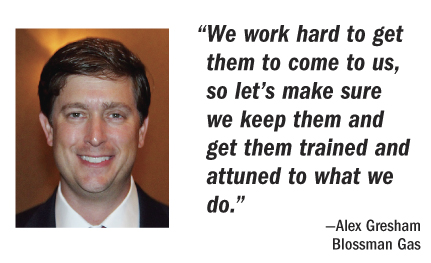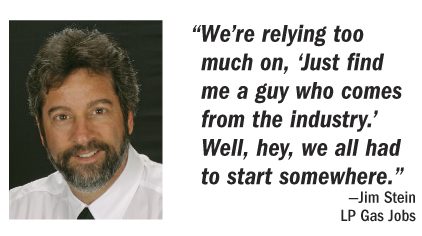Tuesday, May 16, 2017
The idea for the formation of the National Propane Gas Association (NPGA) Workforce Development Task Force began last year as NPGA chairman Stuart Weidie embarked on his travels to different state propane gas association meetings. At those gatherings, he heard repeated concerns from propane marketers about their challenges in attracting and retaining quality employees. 
Weidie shared those comments with the NPGA executive committee. In response, early this year a task force was formed with the objective of providing propane marketers information on techniques for recruiting, hiring, and “onboarding” new employees or integrating them into the organization.

Jane Stroupe, regional project director for the southern region at AmeriGas (Valley Forge, Pa.), is chair of the task force, and Eric Kuster, director of safety and certification for NPGA, is staff liaison. The task force is still in its infancy. Only several conference calls and an in-person meeting preceded the NPGA Southeastern Conference last month.
 “We have quite a number of people who will be retiring from our industry in five to 10 years, and because of that we’re going to be bringing in a lot of newer folks,” Kuster said. “I think there’s a recognition that we’ve got to learn how to talk to, and attract the younger generation of potential employees out there. There is probably going to be significant turnover in the next five to 10 years, so how do we attract that younger workforce? I think it’s going to be critical for us as an industry to be able to move forward and attract the right workforce employees to keep the industry current.”
“We have quite a number of people who will be retiring from our industry in five to 10 years, and because of that we’re going to be bringing in a lot of newer folks,” Kuster said. “I think there’s a recognition that we’ve got to learn how to talk to, and attract the younger generation of potential employees out there. There is probably going to be significant turnover in the next five to 10 years, so how do we attract that younger workforce? I think it’s going to be critical for us as an industry to be able to move forward and attract the right workforce employees to keep the industry current.”
The issue was front and center at the national show in Nashville, where the task force was to meet again. Also, part of the schedule was a session titled “Recruitment and Development: Attracting New Employees to the Propane Industry,” with a focus on various aspects of the recruitment problem.

Alex Gresham, director of human development for Blossman Gas (Ocean Springs, Miss.), was a scheduled presenter at the session, along with Justine Staub, director of workforce development at AmeriGas, and Jim Stein, owner/manager of LP Gas Jobs, a recruiting service for propane companies. Stein’s portion of the presentation involved the recruitment aspect, and Staub covered retention of employees.
Gresham’s focus was to describe “what we do with them when they get here.” He believes the recruitment situation for the propane industry has grown more competitive over the past five to 10 years. He has noticed a shortage of available commercial vehicle drivers applying for positions at his company.
“We’re adjusting to that, looking at ways we can partner with trade schools and junior colleges, those that offer commercial driver’s license [CDL] training, and we’re willing to help a potential employee get trained and get their CDL while learning their job duties if they are the right fit in other categories.”
Gresham noted this Southeastern session was designed to offer a way to help propane companies of all sizes learn some methods that have worked in finding and keeping employees. “We work hard to get them to come to us, so let’s make sure we keep them and get them trained and attuned to what we do.”
How can companies do that? Gresham said a solid company culture is important, and companies should be supportive of training and professional development. He added that his employer promotes from within and strives to support and educate new people rather than throw them out in the field before they know enough to be successful.
“They do not learn everything they need to know in four weeks. There will still be a lot of ongoing learning year to year. [Our onboarding training] just provides them with more direct learning within the first few weeks of employment.”
The company’s new online learning management system (LMS) is an example of that additional early education. Every new Blossman employee takes five initial online courses through the LMS system, including a Propane 101 lesson the company put together that explains aspects such as what propane is and how it is transported.
Once the employees have completed those courses, Blossman puts them through additional sessions based on their specific career path.
“It’s a blended learning environment of both e-learning and field training. We do that so they have a better understanding of our field, how we handle gas, how we deliver it, and what it does for the customer,” Gresham explained.
Field employees go on to spend a week with a field trainer. That program continues to progress as the trainee shadows the trainer to apply some of the concepts from the computer training to actual exercises out in the field.
Gresham mentioned that his company is testing a mentorship program in which a Blossman employee would serve as a contact for any questions that a new worker might have. “The mentor is there to check on the new person’s progress, be a sounding board for questions, and not let them get drawn into other operational demands during their training period.”
Moving into the retention aspect of workforce development, Staub of AmeriGas said that getting employees to identify with your company’s mission and values helps make them loyal to the business.
“They have to feel like you have their best interest at heart and that you have an interest in them and their career,” she said. To help with that, AmeriGas has developed a career advancement program, called the Accelerated Leadership Program. The program encourages field managers to accelerate their careers with the goal of moving up to the director level. The company is looking into similar programs to move field employees into management positions.
AmeriGas’ Accelerated Leadership Program helps the company form a bench of people ready to move into leadership positions when vacancies open. It also makes employees feel that there is a path for them to move up.
“You don’t have to sit around and hope that someone will recognize you,” Staub said. “There is a way you can pursue that next role.” The naming of a district safety champion and a growth champion is an additional program for people who simply want to become more involved with the company.
“These are not only ways to develop employees for the benefit of the company, but it really works to make people feel they’re in the right place and that they’re with a company that cares about their career, cares about their development, and they can see a way forward if they have an interest in that.”
Seasonal employees who work primarily in the winter are an important aspect of the retention issue, and AmeriGas uses various methods to bring the top seasonal workers back year after year. They are valuable because they are trained and ready to come back and be productive.
AmeriGas keeps in touch with them throughout the summer, trying not to let six months pass without making contact. The company sends its newsletter to the seasonal employees, and the local manager might invite them to their district’s picnic.
“If we have CETP [Certified Employee Training Program] training, we might invite them, so we use a variety of different mechanisms to stay in touch with those folks and offer a return bonus if they come back the second or third year,” Staub said.
In the area of recruiting, according to Stein of LP Gas Jobs, marketers want to hire people from within the propane profession, but with many propane workers nearing retirement, the industry has not done the best job promoting itself to the younger generation.
“Therein lies somewhat of a shortfall for attracting qualified people to our industry, specifically drivers and service techs. They are the heartbeat of this industry.”

Stein, who started out as a bobtail driver for CalGas and continued with AmeriGas for 25 years after it acquired CalGas, said that one of the most frustrating things that he hears from prospective employees applying for positions is that they do not hear back from propane companies after submitting an application. And if they do hear back, typically several weeks later, they have already found another job. Timing is critical, and if you don’t touch base with prospective applicants within a few days, you’re probably too late.
He would like to see the industry hold more discussions on how to make the profession more “attractive, cool, and exciting” to the younger generation.
“I don’t have a magic answer for that, but we’re relying too much on, ‘Just find me a guy who comes from the industry.’ Well, hey, we all had to start somewhere. The days of getting your mailbox filled with people applying are over. Why, I don’t know.”
Stein would also like to see a discussion on wages. He believes the propane industry pays competitive wages in some areas of the country and is less competitive in others. Employees have also told him that they did not receive enough training for their position. Growth opportunity is yet another area of concern he has heard about from prospective employees.
“Companies need to be serious about training and not so much just looking for that next guy where they could just stick him in the truck with the old, ‘hit the ground running’ adage,” Stein stressed. “That’s OK to a point, but there is some drawback to not providing good quality training to folks who get hired. If they don’t [receive the training], then we continue to limit ourselves as an industry in bringing folks from outside.”
Task force chair Stroupe echoed the issue of the propane industry’s aging workforce and the need to fill those positions when those longtime employees retire.
“Hopefully we’re going to be able to retire at some point in the near future, and we don’t really have people to backfill these positions or to fill the positions that are going to become available because people are retiring or leaving the industry. Our goals are to come up with deliverables to give the membership ways to recruit, train, and retain qualified employees. There is a shortage of CDL drivers, so not only does our project target drivers and service techs, but we’re looking at recruiting manager-level employees, too. Whether we recommend a recruiting company or some of the online websites, there’s just an array of tools we’re exploring,” Stroupe said.
At the Southeastern meeting in April, the task force planned to discuss “deliverables” that could help marketers meet goals to recruit, train, and retain qualified employees. Kuster said that strategic partnerships with returning military veterans and other groups was one of those possible deliverables.
“Also, how do we leverage part-time or seasonal drivers that may be working for another company? We have also talked about CSRs, service techs, and management personnel and how we onboard them and how we retain those good quality employees,” Kuster added. “There are a lot of good concepts. Now we’re moving toward implementation and deliverables, and that’s our next step.”
—Daryl Lubinsky

Weidie shared those comments with the NPGA executive committee. In response, early this year a task force was formed with the objective of providing propane marketers information on techniques for recruiting, hiring, and “onboarding” new employees or integrating them into the organization.

Jane Stroupe, regional project director for the southern region at AmeriGas (Valley Forge, Pa.), is chair of the task force, and Eric Kuster, director of safety and certification for NPGA, is staff liaison. The task force is still in its infancy. Only several conference calls and an in-person meeting preceded the NPGA Southeastern Conference last month.
 “We have quite a number of people who will be retiring from our industry in five to 10 years, and because of that we’re going to be bringing in a lot of newer folks,” Kuster said. “I think there’s a recognition that we’ve got to learn how to talk to, and attract the younger generation of potential employees out there. There is probably going to be significant turnover in the next five to 10 years, so how do we attract that younger workforce? I think it’s going to be critical for us as an industry to be able to move forward and attract the right workforce employees to keep the industry current.”
“We have quite a number of people who will be retiring from our industry in five to 10 years, and because of that we’re going to be bringing in a lot of newer folks,” Kuster said. “I think there’s a recognition that we’ve got to learn how to talk to, and attract the younger generation of potential employees out there. There is probably going to be significant turnover in the next five to 10 years, so how do we attract that younger workforce? I think it’s going to be critical for us as an industry to be able to move forward and attract the right workforce employees to keep the industry current.”The issue was front and center at the national show in Nashville, where the task force was to meet again. Also, part of the schedule was a session titled “Recruitment and Development: Attracting New Employees to the Propane Industry,” with a focus on various aspects of the recruitment problem.

Alex Gresham, director of human development for Blossman Gas (Ocean Springs, Miss.), was a scheduled presenter at the session, along with Justine Staub, director of workforce development at AmeriGas, and Jim Stein, owner/manager of LP Gas Jobs, a recruiting service for propane companies. Stein’s portion of the presentation involved the recruitment aspect, and Staub covered retention of employees.
Gresham’s focus was to describe “what we do with them when they get here.” He believes the recruitment situation for the propane industry has grown more competitive over the past five to 10 years. He has noticed a shortage of available commercial vehicle drivers applying for positions at his company.
“We’re adjusting to that, looking at ways we can partner with trade schools and junior colleges, those that offer commercial driver’s license [CDL] training, and we’re willing to help a potential employee get trained and get their CDL while learning their job duties if they are the right fit in other categories.”
Gresham noted this Southeastern session was designed to offer a way to help propane companies of all sizes learn some methods that have worked in finding and keeping employees. “We work hard to get them to come to us, so let’s make sure we keep them and get them trained and attuned to what we do.”
How can companies do that? Gresham said a solid company culture is important, and companies should be supportive of training and professional development. He added that his employer promotes from within and strives to support and educate new people rather than throw them out in the field before they know enough to be successful.
“They do not learn everything they need to know in four weeks. There will still be a lot of ongoing learning year to year. [Our onboarding training] just provides them with more direct learning within the first few weeks of employment.”
The company’s new online learning management system (LMS) is an example of that additional early education. Every new Blossman employee takes five initial online courses through the LMS system, including a Propane 101 lesson the company put together that explains aspects such as what propane is and how it is transported.
Once the employees have completed those courses, Blossman puts them through additional sessions based on their specific career path.
“It’s a blended learning environment of both e-learning and field training. We do that so they have a better understanding of our field, how we handle gas, how we deliver it, and what it does for the customer,” Gresham explained.
Field employees go on to spend a week with a field trainer. That program continues to progress as the trainee shadows the trainer to apply some of the concepts from the computer training to actual exercises out in the field.
Gresham mentioned that his company is testing a mentorship program in which a Blossman employee would serve as a contact for any questions that a new worker might have. “The mentor is there to check on the new person’s progress, be a sounding board for questions, and not let them get drawn into other operational demands during their training period.”

Moving into the retention aspect of workforce development, Staub of AmeriGas said that getting employees to identify with your company’s mission and values helps make them loyal to the business.
“They have to feel like you have their best interest at heart and that you have an interest in them and their career,” she said. To help with that, AmeriGas has developed a career advancement program, called the Accelerated Leadership Program. The program encourages field managers to accelerate their careers with the goal of moving up to the director level. The company is looking into similar programs to move field employees into management positions.
AmeriGas’ Accelerated Leadership Program helps the company form a bench of people ready to move into leadership positions when vacancies open. It also makes employees feel that there is a path for them to move up.
“You don’t have to sit around and hope that someone will recognize you,” Staub said. “There is a way you can pursue that next role.” The naming of a district safety champion and a growth champion is an additional program for people who simply want to become more involved with the company.
“These are not only ways to develop employees for the benefit of the company, but it really works to make people feel they’re in the right place and that they’re with a company that cares about their career, cares about their development, and they can see a way forward if they have an interest in that.”
Seasonal employees who work primarily in the winter are an important aspect of the retention issue, and AmeriGas uses various methods to bring the top seasonal workers back year after year. They are valuable because they are trained and ready to come back and be productive.
AmeriGas keeps in touch with them throughout the summer, trying not to let six months pass without making contact. The company sends its newsletter to the seasonal employees, and the local manager might invite them to their district’s picnic.
“If we have CETP [Certified Employee Training Program] training, we might invite them, so we use a variety of different mechanisms to stay in touch with those folks and offer a return bonus if they come back the second or third year,” Staub said.
In the area of recruiting, according to Stein of LP Gas Jobs, marketers want to hire people from within the propane profession, but with many propane workers nearing retirement, the industry has not done the best job promoting itself to the younger generation.
“Therein lies somewhat of a shortfall for attracting qualified people to our industry, specifically drivers and service techs. They are the heartbeat of this industry.”

Stein, who started out as a bobtail driver for CalGas and continued with AmeriGas for 25 years after it acquired CalGas, said that one of the most frustrating things that he hears from prospective employees applying for positions is that they do not hear back from propane companies after submitting an application. And if they do hear back, typically several weeks later, they have already found another job. Timing is critical, and if you don’t touch base with prospective applicants within a few days, you’re probably too late.
He would like to see the industry hold more discussions on how to make the profession more “attractive, cool, and exciting” to the younger generation.
“I don’t have a magic answer for that, but we’re relying too much on, ‘Just find me a guy who comes from the industry.’ Well, hey, we all had to start somewhere. The days of getting your mailbox filled with people applying are over. Why, I don’t know.”
Stein would also like to see a discussion on wages. He believes the propane industry pays competitive wages in some areas of the country and is less competitive in others. Employees have also told him that they did not receive enough training for their position. Growth opportunity is yet another area of concern he has heard about from prospective employees.
“Companies need to be serious about training and not so much just looking for that next guy where they could just stick him in the truck with the old, ‘hit the ground running’ adage,” Stein stressed. “That’s OK to a point, but there is some drawback to not providing good quality training to folks who get hired. If they don’t [receive the training], then we continue to limit ourselves as an industry in bringing folks from outside.”
Task force chair Stroupe echoed the issue of the propane industry’s aging workforce and the need to fill those positions when those longtime employees retire.
“Hopefully we’re going to be able to retire at some point in the near future, and we don’t really have people to backfill these positions or to fill the positions that are going to become available because people are retiring or leaving the industry. Our goals are to come up with deliverables to give the membership ways to recruit, train, and retain qualified employees. There is a shortage of CDL drivers, so not only does our project target drivers and service techs, but we’re looking at recruiting manager-level employees, too. Whether we recommend a recruiting company or some of the online websites, there’s just an array of tools we’re exploring,” Stroupe said.
At the Southeastern meeting in April, the task force planned to discuss “deliverables” that could help marketers meet goals to recruit, train, and retain qualified employees. Kuster said that strategic partnerships with returning military veterans and other groups was one of those possible deliverables.
“Also, how do we leverage part-time or seasonal drivers that may be working for another company? We have also talked about CSRs, service techs, and management personnel and how we onboard them and how we retain those good quality employees,” Kuster added. “There are a lot of good concepts. Now we’re moving toward implementation and deliverables, and that’s our next step.”
—Daryl Lubinsky

